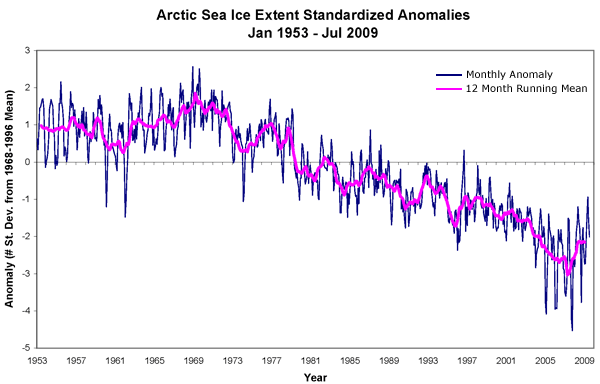Explaining Arctic sea ice loss
Posted on 13 October 2010 by Doug Bostrom
Arctic sea ice has aptly been termed a "canary in the global warming coal mine," a sensitive indicator of climate change; because of its importance as a diagnostic of global warming, climate change skeptics struggle to explain the decline of Arctic sea ice as a natural phenomenon.
Satellite measurements of Arctic sea ice extent reveal a rapid decline over the past 30 years, particularly at the end of each year's annual melt season. The downward trend and the increasing difference between seasons are in keeping with predictions of the effects of global warming. As the Arctic warms, the volume of ice in the region gradually declines, making it less likely ice will survive more than one year and thus exposing more open water at the end of each melt season (Maslanik et al).

(from National Snow and Ice Data Center )
As an explanation for the decline of Arctic sea ice, skeptics hypothesize we're seeing the effects of natural cycles causing deep, decades-long swings in Arctic ice coverage and volume. Lending observational support for such cycles is much more difficult than relying on direct observations of ice extent with contemporary instruments. Still, thanks to ocean sediment cores and some other physical clues left by past climate regimes we have reasonable insight into past Arctic sea ice extent. Combining various information about past climate behavior, we can better understand why changes in ice coverage have occurred in past times, whether those natural variations are happening today, and how those changes compare to today's sea ice trend.
While it's true that natural variations of the climate have caused significant changes in Arctic ice extent in the past, it's important to note that such such changes are not airtight arguments against anthropogenic global warming causing today's loss of ice. After all, events of the past do not describe newly identified influences by human culture on today's climate. Indeed, comparisons between past and present Arctic climate reveal different reasons for yesterday's and today's Arctic sea ice changes and strongly suggest that today's changes are largely anthropogenic (Overpeck et al). Meanwhile, analysis of several hundred indicators of past Arctic sea ice extent tells us that recent losses appear to have no parallel in records going back many thousands of years (Polyak et al).
The past 200 years offers an example of how natural and anthropogenic influences on Arctic sea ice can be distinguished. The Arctic appears to have undergone an unusually cool period in the early 19th century, certainly natural, with recovery to more normal conditions extending into the 20th century leading to the warming we see today. Referring to the graph above, we can see that after the earlier cool period sea ice extent in the Arctic appears to have largely stabilized, later to begin a steady decline in chorus with other emerging observations of global warming such as increasing air and ocean temperatures. This decline in ice extent is happening even though the causes for natural recovery from the unusual cold of the 19th century are no longer in play, while research strongly suggests these recent reductions in Arctic sea ice are are caused by a new, anthropogenic mechanism (Johannessen et al).
In sum, although natural factors have always influenced the state of Arctic sea ice, research strongly suggests that today's decline is driven by the novel influence of anthropogenic C02 we've added to the atmosphere and thus is unique in Earth's history.
This post is the Basic Version (written by Doug Bostrom) of the skeptic argument "Arctic ice melt is a natural cycle".































 Arguments
Arguments
























 0
0  0
0






Comments